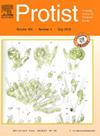Description of new diplonemids (Diplonemea, Euglenozoa) and their endosymbionts: Charting the morphological diversity of these poorly known heterotrophic flagellates
IF 2.1
3区 生物学
Q4 MICROBIOLOGY
引用次数: 0
Abstract
Diplonemids are a hyperdiverse group of flagellated protists, but with less than two dozen formally described representatives. Here, we describe four new species of cultured diplonemids, identified on the basis of their 18S rRNA sequences, light-, fluorescence-, scanning- and transmission electron microscopy. Three new species belong to the genus Rhynchopus (R. asiaticus sp.n., R. granulatus sp.n., and R. valaseki sp.n.), while the fourth species is an unusual representative of the genus Lacrimia (L. aflagellata sp.n.). The latter organism is the first diplonemid outside the genus Rhynchopus (as defined previously) to show a gliding trophic stage with flagellar stubs concealed inside the flagellar pocket and a highly motile dispersive swimming stage. Since this character is thus no longer a genus-specific apomorphy, we provide a taxonomic revision of the genus Rhynchopus with separation of the new genus Natarhynchopus gen. n. We also identify bacterial endosymbionts of L. aflagellata and R. asiaticus as Ca. Syngnamydia medusae (Chlamydiales, Simkaniaceae) and Ca. Cytomitobacter rhynchopi sp. n. (Alphaproteobacteria, Holosporaceae), respectively, and discuss their potential functions. This is the first report of a chlamydial symbiont within a diplonemid host. We also propose that diplonemids may serve as vectors for chlamydial pathogens of marine fish.
新双鞭毛纲(双鞭毛纲,真鞭毛纲)及其内共生生物的描述:绘制这些鲜为人知的异养鞭毛纲的形态多样性
双尾虫是一个高度多样化的鞭毛原生生物群体,但只有不到24个正式描述的代表。在这里,我们描述了四种新的培养双花属植物,根据它们的18S rRNA序列,光,荧光,扫描和透射电子显微镜鉴定。文章属三新种(R. asiaticus sp.n.)。;;;;第4种为泪虫属(L. aflagellata sp.n.)的罕见代表种。后一种生物是除Rhynchopus属(如前所述)外第一个显示出滑翔营养阶段(鞭毛残根隐藏在鞭毛袋内)和高度运动性分散游泳阶段的双翅虫。由于这一特征不再是属特异性的无形态,我们对Rhynchopus属进行了分类修订,分离出了新属Natarhynchopus gen. n。我们还鉴定了L. aflagellata和R. asiaticus的细菌内共生体分别为Ca. Syngnamydia medusae (Chlamydiales, Simkaniaceae)和Ca. Cytomitobacter rhynchopi sp. n. (Alphaproteobacteria, Holosporaceae),并讨论了它们的潜在功能。这是首次在双孔虫寄主体内发现衣原体共生体。我们还提出双孔虫可能是海鱼衣原体病原体的载体。
本文章由计算机程序翻译,如有差异,请以英文原文为准。
求助全文
约1分钟内获得全文
求助全文
来源期刊

Protist
生物-微生物学
CiteScore
3.60
自引率
4.00%
发文量
43
审稿时长
18.7 weeks
期刊介绍:
Protist is the international forum for reporting substantial and novel findings in any area of research on protists. The criteria for acceptance of manuscripts are scientific excellence, significance, and interest for a broad readership. Suitable subject areas include: molecular, cell and developmental biology, biochemistry, systematics and phylogeny, and ecology of protists. Both autotrophic and heterotrophic protists as well as parasites are covered. The journal publishes original papers, short historical perspectives and includes a news and views section.
 求助内容:
求助内容: 应助结果提醒方式:
应助结果提醒方式:


